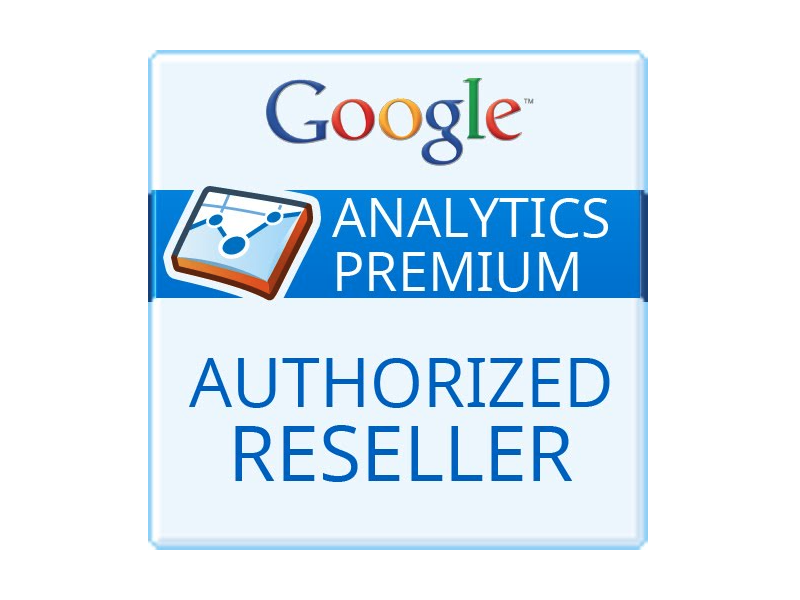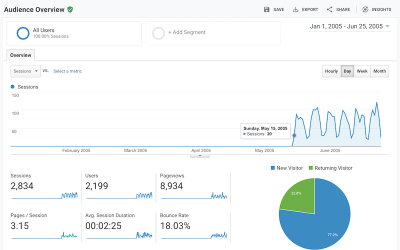Let’s face it, free is a great price point and the free version of Google Analytics is a great product. In fact, there are numerous multi-nationals using Google Analytics – not because they can’t afford a paid-for tool, but simply because is it good.
So why use a paid-for tool? A client considering GA Premium (the paid-for version of Google Analytics) asked me the following question about cost recently:
“One thing that would be great to cover in our meeting, is the value of the Premium product for us. How will it save us money by spending $150k a year instead of simply adjusting our approach and using the free product?”
That’s a great question – getting right to the point of cost versus value for money. This is my two-point response that can be applied to any paid-for vendor…
(fyi: Premium cost: $150k USD, €105k euros, or £90k GBP per year)
Point 1: Don’t upgrade to a paid solution unless you have RESOURCE
If analysis is going to be someone’s full-time job – that is, working on bringing insights to the business on a day-to-day basis, then consider Premium as the right tool (even more so if there is a team of people involved). On the other hand, if the investment in analysis is only part-time, say 1 day per week, I would recommend sticking to the free product.
Why is staffing so important?
Spending 1-2 days per week analysing your reports will not allow you to explore all the capabilities of the Premium product at any depth. You would be constantly scratching the surface without the time to go deep. Of course you could still hire a us to do the deep-dive stuff with the free version. However, if you have a popular website (say more than 10m pageviews per month), then sampling, data freshness and data retention are going to be important areas that will limit how deep we can go. These are Premium features.
BC RULE #1
If you cannot commit 1 full-time analyst, do not pay for an analytics tool.
Point 2: Calculate your website VALUE and ensure you get a return
Calculating the value of your website is straightforward when you are tracking transactions – you get its total value plotted over time and the value of each page and the value of each visitor – broken down by referrer source and campaign etc. – automatically calculated for you by Google Analytics.
If you are a lead generation/content website (the vast majority of enterprise websites are not e-commerce), then value is much harder to calculate. In fact, I rarely see the calculation even attempted. However, monetising your non-transactional site is critical to your success. Without it, and there is a serious danger your website is just a pet project – nice to have, but not treated as a serious part of the business. Hence $150k per year for a measurement tool is never going to see the light of day in your organisation – and rightly so – unless you can put a monetary value on it.
As Jim Sterne would say:
“You need to calculate the ROI of measuring your ROI…“
(read related post on value in GA)
Monetising conversion processes are the most important part of a analyst’s job role…
I have discussed in detail the monetisation of non-transactional websites in my books. Its not rocket science, but does require time and energy to logically think through and identify your website’s goals (aka: Call to Actions) and assign values to them.
At the end of the day, only something that impacts the business bottom line is going to receive investment – be that extra people or budget for your team. Therefore, monetisation is a key step to understanding what resource and therefore what measurement tools are appropriate to invest in.
Here’s an example:
If your conversion funnel (e-commerce or not) is a $10 million per year revenue generator for you, $150k is of the order of 1-2% of that revenue. If GA Premium can help you improve your conversion rate by a mere 1-2% it will have paid for itself.
Putting this into perspective:
- If your lead generating form (new sales enquiry) has an “industry average” conversion rate of 3.00%
- and your sales team is able to convert 1 in 10 leads to a customer (this is a fixed conversion rate)
- Then improving your site content and/or its marketing so that the lead generation form converts at 3.06% will pay for your GA Premium account!
Is that achievable for your website? I would say that is achievable for *ANY* website.
If your conversion funnel generates $1 million per year, then you would need to improve your conversion rate to 3.6% to achieve the same pay off. That is still very attainable in my experience, just harder. I therefore consider this as the Tipping Point for your investment…
BC RULE #2
If your website is not contributing at least $1m USD per year to your business, do not pay for a web analytics tool.
Hopefully this puts paid-for web analytic tools such as Google Analytics Premium into perspective when it comes to value for money. BTW, for the difference in data limits of free versus Premium, read this post from me: Google Analytics Limits – a reference guide.
I would love to hear your thoughts on paying for a data collection/reporting tool? [ This article was originally written by me on November 2011 – when GA Premium launched ]
Disclaimer: My company is an authorised Google Analytics Premium reseller. If you want to work with me on Premium, please contact search-integration.com




@Kit – thanks for feedback.
from a “limits” perspective the major difference of Premium is:
BTW, you can have access to an unlimited number of accounts in free. The limit of 25 is just for creation via the UI. To overcome this, simply use another google account for the initial creation, then add your “original” login details for Admin access. Its a little awkward but should not be a problem for you.
More limit info in my post:
https://brianclifton.com/blog/2012/10/16/google-analytics-limits-a-reference-guide/
Hi, Brian,
One thing I can’t seem to find out about is how the limits set in the Free version might differ with the Premium version. With Premium can I get more than 50 profiles per account or more than 25 accounts per login? For our large government organization, some of these size considerations are important. Of course, with over 20M pageviews per month we’re also wondering about the ability to see into the details of such a large pot of data; does Google’s processing limit increase for a Premium user?
If the $150K cost includes implementation assistance (figuring out how to set this up across multiple domains and subdomains, how to coordinate event tracking, etc.) and training (helping our extended team manage this setup and build a reporting activity), this cost seems pretty reasonable, and it’ll be more reasonable if some of those limits go up. Maybe this is where the API and/or 3rd party tools come in handy? (So much to learn and investigate, especially with GA changing so much every month!)
Thanks for all the great documentation you’ve got out there on this amazing product!!
Cheers for the compliment Steve – with the battle against information overload that web analysts face every day, I like to keep it simple :0)
Its a rule of thumb guide, in the same way as Avinash’s 90:10 rule i.e. it really does not matter if its 85:15 or 70:30 – that’s not the point…
I like your guidelines Brian.
Both nice and simple and dead easy to remember. Simplistic yes but the point is right on the button.
a) Anyone can understand them.
b) The $1M is a decent benchmark.
Neither guideline need be set in stone but as a starting point I think it’s a common sense approach.
@Brian – I have noticed slow loading this week. It occasionally happens. GA runs on the same infrastructure as everything else, so who knows what might be hogging resources… I don’t see any conspiracy here!
Regarding free GA, if you have 5 million pageviews a month, GA is nearly unusable. Half the time reports take 60 seconds to be generated, the other half of the time they crash (“… services on which we depend have become unavailalbe”). I hear this has gotten worse lately. Can you verify this?
Regarding Premium, are these resource limitations for free GA Google’s way of getting larger sites to switch to Premium?
@Brian,
ha ha, it’s not that are paid well, I mean for the most part they aren’t paid.
It was more the rule of thumb that goes whatever you pay someone, multiply it by 3 to get the amount they have generate before it’s worth while to actually employ them.
So say you want to employ a decent marketer/analyst who knows what they are doing you’re certainly getting close to the $80-100k mark. Times that by 3 and add in the cost of the Premium tool and the cost quickly mounts up. (even if you took a freshly minted business school grad, you’d still be up for significant cost.)
But really all I’m doing is reinforcing your point that a company needs to get significant return from it to make it worthwhile.
As for your second point, it’s not that they don’t want to get on top of it, they do (that’s why they pay me as a consultant)
What I was getting at is that the thought of hiring someone full time to work solely on analysis would be a big leap for them, and they could quite easily think of several other professional staff they would rather have before getting an analyst.
And that’s without even considering the issue of if they could even find someone.
To be fair, it is these companies approaching or around the $10m mark that are grappling with these very issues: How do we use analytics effectively, how do we make it work for us, how do we use to to move the business to the next level etc.
And of course that means setting aside a budget for it, which is something they haven’t had to do before (at least not in a significant way), so it’s all new, or at best a work in progress.
@Yehoshua Coren – You are absolutely right in that the feature differences between GA free and Premium are very small. Though I expect that to grow over time, I don’t expect the gap to be very large.
For my clients the criteria comes down to 2 things:
@Make Them Click – wow, analysts are paid very well in Oz… though I would suggest $100k USD will get you a good/experienced analyst.
I find it amazing that a company who has $10m a year going through its website does not want to get on top of what’s actually happening…! Its like saying “we don’t need a financial director to run our business, just wing it”…
Don’t worry I believe you. I come across this attitude all the time in Europe (much, much less so in the US). Though typically its for corporate/non-transaction sites where value has not even been considered. It surprises that an e-commerce site would operate like that. They must be making too much money to care! That will catch them out one day though…
G’day Brain, greetings from downunda,
I think the $1m price point is actually too low. I would say make it $10 million before paying for a premium solution.
If you’re going to employ a full time staff person, then the cost of employing them plus the cost of a paid solution will eat up almost half of the $1m figure, which is probably all of the profit.
So it’s just not viable at that price point.
I have clients around the $10m mark and even they would baulk at appointing a full time analyst.
Plus they aren’t even close to utilising the full potential of GA yet.
I must admit, I haven’t seen where the $150K price point for GA Premium is really worth it. Specifically in response to point #2 – as someone who has access to GA Premium and GA Standard, I don’t see a $150K benefit to the Premium product. Granted, I don’t particularly appreciate the need for the SLAs; perhaps that is because I’ve found GA standard to be really quite reliable over the past few years.
I definitely appreciate that 50 Custom Variables is *way* better than 5. (I wish that GA Standard would bump us up to 10….) But apart from that, products like Analytics Canvas can overcome the sampling limits of the API in most cases through query partitioning so the Unsampled Reports carry less weight. And I haven’t seen an expansion of the data tables to date (i.e. still getting lots of “other” on GA Premium accounts).
Bottom line, I am unsure that GA Premium really has the potential to improve conversion rates by the 1-2% needed to have a positive ROI needed for enterprise sites as you suggested, Brian. The biggest mitigating factor being, imho, the support package which may indeed help some enterprise companies significantly.
Great conversation building here, though bear in mind with this post:
– I am assuming that an organisation is considering upgrading form GA free to Premium, as my client was asking.
– They have a need for GA Premium “features”, but could make do with the free version by modifying their data collection approach – as can any user.
@Ben Gott – Great question. An advertising spend model could work just as well. For example, it would be reasonable (very!) to expect the right WA tool to be able to help you improve your online marketing by 10% over a year. This can be gaining you 10% more leads for the same price, or providing the same number of leads for 10% less.
So an annual digital marketing budget of ~$1.5m would be the tipping point in this case. However, the issue with not taking the “revenue” into account, is that this value raises the bar much higher for a company…
@Benoit Arson – of course if you view Google as a competitor, then use an alternative. However, that can still be free – Yahoo Analytics for example. Piwik also has a strong following as well (http://piwik.org).
Agreed – there are a number of WA tools can come in at a lot less than $150k – Urchin Software is one that is under a tenth of the price! However, at that price point I am not aware of any paid tool that can compete with the features of the free GA version.
@Peter O’Neill – I kind of agree, though bear in mind the 10m pageview limit of the free version of GA. Some companies just need more horsepower.
@Michael N – Agree. The “business context” is the critical link. Knowing a product inside out and how to install it is not enough.
@Mike Upton – good point on also including website ROI. In this case I am thinking of GA Premium which is the exact same implementation as the free version.
Hello,
I agree with you about the importance of calculating the ROI from a WA tool. If I read your post, I conclude that very few companies need to use a paid-for tool.
But companies have to take in account other elements :
– the difference of level in the features offered by free and paid-for tools; we can’t assume that every solution are equivalent
– you don’t need to spend 150K$ to take benefit of all paid-for tools ; many of them are less expensive.
– Service Level Agreement,
– dedicated service,
– data ownership.
I want to insist on this last point
The question should be: Should you pay $150,000 for owning your data? Should you pay $150,000 for not sharing your data with one of your competitors?
Maybe, there would be more companies ready to pay.
Google is a search engine, a Sponsored links provider (Adwords, Adsense), a price comparison service, an ad management and ad serving technology (Double click), a RSS reader, a social networking service (Google +), a news compilation service (Google news),…, a Mapping service (Google Maps), a webmail (Gmail), an operating system for mobile (Android), a TV platform, a browser (Chrome),…, an hotel booking service (Google Hotel Finder), a flight booking service (Google Flight Search),…
So Google becomes one of the competitors of a growing number of companies.
Are web analytics agencies ready to tell this to their clients when choosing a WA tool? I’m not sure. Depending on the industry of your customer, this may have an impact on the survival of your customer’s company. Companies need to be aware of this issue.
Benoit
Hi Brian,
Thanks for putting this out there, I think the revenue context helps to concrete this idea more than something like the 10/90 rule.
In the case where revenue is much harder to pin down, do you think an advertising spend model could be relevant? i.e if you spend more than x and you have a conversion rate of less than y…….
Cheers,
Ben
Very interesting read, thanks. There’s one point I’d like to add though for anyone considering this:
When discussing the requirement of investing in resource to analyse web data then I feel it would be remiss not to also discuss the need of resource that can implement the solutions to any of actions that are unearthed.
Investing in full time web analysts will no doubt provide any medium to large enterprise with some great insights in to what is profitable and what’s not and also what to focus on to drive additional revenue. Often it will then be the role of the web development team to implement changes to the website or of other departments to make changes based on the data. In my opinion it is equally important to ensure that there is resource in these other facets of the business as it is to have the web analysts in the first places as if you don’t then you end up with a list of things to drive revenue and no resource to put them in place. This can also extend to other factors such as the limitations of a ERP or a CMS that could also hold back any potential gains which can also be a consideration in the decision too.
Very good points – maybe a bit simple in a way – still it makes a lot of sense.
Regarding point #1) there are indeed many companies that pay for a WA tool but do not have dedicated resources or rely on part-time consultants. Extracting insights from data requires time – need to know the tool but also the business context that is unique to every single company. Something very difficult when working part-time (even if you are a WA crack)
Regarding point #2) Monetization is a must do to calculate your WA ROI – but also your website ROI. Problem is that many are reluctant to do the exercise – too afraid of what may be the outcome… Discovering that their website ROI is not as sexy as they sell it. But without any ROI demonstration – no chance you can convince anyone to invest in a WA tool or worse, in dedicated resources.
Cheers,
Michael
Good simple points Brian but I would argue that a company needs to commit at least two full-time analysts, not just one. They will get more value (higher ROI) from employing a second analyst to use their free tool than through investing in any paid web analytics tool with only a single full analyst to use.
Cheers
Peter